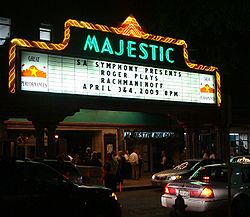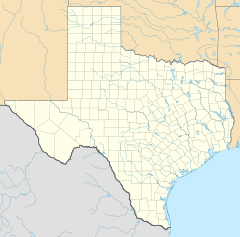- Majestic Theatre (San Antonio, Texas)
-
This article is about the San Antonio theater. For other uses, see Majestic Theatre (disambiguation).Majestic TheatreRecorded Texas Historic Landmark
Location: San Antonio, Texas Coordinates: 29°25′34″N 98°29′24″W / 29.42611°N 98.49°WCoordinates: 29°25′34″N 98°29′24″W / 29.42611°N 98.49°W Built: 1929 Architect: Eberson,John Architectural style: Skyscraper, Mission/spanish Revival Governing body: Local NRHP Reference#: 75001952[1] Significant dates Added to NRHP: October 1, 1975 Designated RTHL: 1991 The Majestic Theatre is San Antonio's oldest and largest atmospheric theatre. The theatre seats 2,311 people and was designed by architect John Eberson, for Karl Hoblitzelle's Interstate Theatres in 1929.
In 1975, the theatre was listed on the National Register of Historical Places and was designated a National Historic Landmark in 1993. The theatre has been home to the San Antonio Symphony, since 1989. For many years, it remained the largest theatre in Texas and the second largest movie theatre in the United States. It was also the first theatre in the state to be totally air-conditioned.
Contents
History
The land on which the office building-theatre complex now stands was leased to Karl Hoblitzelle from J. M. Nix, who had purchased it in 1920 from the Enterprise Company of Dallas. The land came with the curious deed restriction that, until April 5, 1928, "'neither aforesaid land nor any building or improvement or any part thereon shall be used or occupied for theatrical, motion picture, or amusement purposes at any time...'"[2]
Sufficiently exceeding the listed time restriction, the theatre's opening on June 14, 1929, in many ways symbolized a progressiveness with which San Antonio wished to identify. The city actually deemed the month of the opening "Prosperity Month," celebrating the recent era of development Texas was experiencing. In size, the Greater Majestic was second in the nation only to Atlanta, Georgia's Fox Theatre, and it was the first theatre in Texas to be fully air-conditioned, something that alone was a major attraction in the 1920s Southwest. Advertisements heralding "'an acre of cool, comfortable seats'" were "further emphasized by the snow which topped the letters of the theatre's name,"[3] prompting society women to wear fur coats to the June opening.[4] The 4000-seat theatre was filled to capacity for opening day entertainment, which consisted of the musical film, Follies of 1929 and live performances by Mexican Troubador Don Galvan, "The Banjo Boy," the "Seven Nelsons" acrobatic troupe, Eddie Sauer and his "Syncopaters," and the Father of Country Music, Jimmie Rodgers, who himself received 18 curtain calls.[5] Each week, the program offered included a new film and a new lineup of star performers. In 1930, the Great Depression caused the Majestic to close for several weeks, until it was able to reopen "because Americans were turning to movies for escape." The Majestic provided that escape with a schedule of films and live entertainment through the 1940s and 50s.[6]
Theatre features included a huge cast-iron canopy covering the sidewalk, a vertical sign 76-feet tall topped with "a strutting peacock ... walking as a huge ball rotated under his feet," and a cave-like single-story lobby that included copper lanterns, ceiling murals, and an aquarium filled with tropical fish.[7] Inside the theatre's auditorium were stuffed birds perched on balconies or frozen mid-flight via ceiling wire, replicas of well-known Greek, Roman, and Renaissance sculptures, and specially treated cypress trees brought from Spain and placed on upper-level niches. The Baroque tendency to decorate with mask-like faces is exemplified by carvings alongside the stage and under the mezzanine balcony, and in direct translation of atmospheric theater design, the Majestic's blue ceiling "cloud scape" disguises the interior dome as an evening sky in conjunction with a cloud projector and small bulbs simulating stars. The bulbs are actually positioned according to consultations with experts at the National Geographic Society, who instructed the designer as to the positioning of the real stars on the night of the theater's opening.
Pop culture
The world premiere of The Texans (1938) was held at the Majestic on July 16, 1938.[8]
The world premiere of The Lusty Men (1952) was held at the Majestic in 1952 with stars Robert Mitchum, Arthur Kennedy and Arthur Hunnicutt attending.[8]
Gallery
References
- ^ "National Register Information System". National Register of Historic Places. National Park Service. 2007-01-23. http://nrhp.focus.nps.gov/natreg/docs/All_Data.html.
- ^ Preddy, Jane. "The Greater Majestic Theatre." Marquee: Journal of the Theatre Historical Society of America 20 (1988): 5.
- ^ Preddy, Jane. "The Greater Majestic Theatre." Marquee: Journal of the Theatre Historical Society of America 20 (1988): 5-7.
- ^ "Majestic Theatre". Frommer's 2010-2-15.
- ^ Preddy, Jane. "The Greater Majestic Theatre." Marquee: Journal of the Theatre Historical Society of America 20 (1988): 7.
- ^ Pinkard, Tommie. "The Stars Shine Again at the Majestic". Texas Highways January 1983: 22.
- ^ Preddy, Jane. "The Greater Majestic Theatre." Marquee: Journal of the Theatre Historical Society of America 20 (1988): 9-10.
- ^ a b Thompson, Frank. Texas Hollywood: Filmmaking in San Antonio Since 1910. San Antonio: Maverick Publishing Company, 2002.
External links
U.S. National Register of Historic Places Topics Lists by states Alabama • Alaska • Arizona • Arkansas • California • Colorado • Connecticut • Delaware • Florida • Georgia • Hawaii • Idaho • Illinois • Indiana • Iowa • Kansas • Kentucky • Louisiana • Maine • Maryland • Massachusetts • Michigan • Minnesota • Mississippi • Missouri • Montana • Nebraska • Nevada • New Hampshire • New Jersey • New Mexico • New York • North Carolina • North Dakota • Ohio • Oklahoma • Oregon • Pennsylvania • Rhode Island • South Carolina • South Dakota • Tennessee • Texas • Utah • Vermont • Virginia • Washington • West Virginia • Wisconsin • WyomingLists by territories Lists by associated states Other Categories:- Buildings and structures in San Antonio, Texas
- Culture of San Antonio, Texas
- Theatres in Texas
- 1929 architecture
- John Eberson buildings
- Atmospheric theatres
Wikimedia Foundation. 2010.






